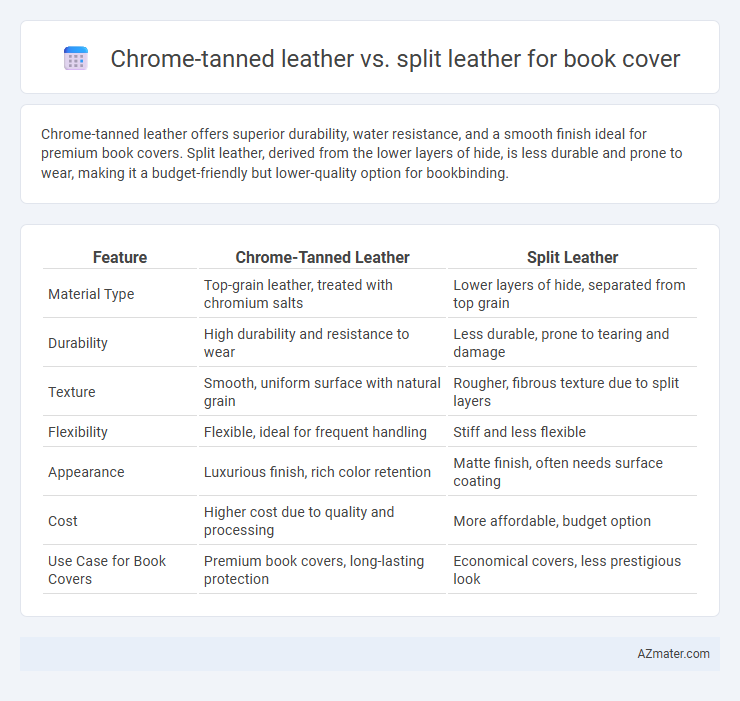Chrome-tanned leather offers superior durability, water resistance, and a smooth finish ideal for premium book covers. Split leather, derived from the lower layers of hide, is less durable and prone to wear, making it a budget-friendly but lower-quality option for bookbinding.
Table of Comparison
| Feature | Chrome-Tanned Leather | Split Leather |
|---|---|---|
| Material Type | Top-grain leather, treated with chromium salts | Lower layers of hide, separated from top grain |
| Durability | High durability and resistance to wear | Less durable, prone to tearing and damage |
| Texture | Smooth, uniform surface with natural grain | Rougher, fibrous texture due to split layers |
| Flexibility | Flexible, ideal for frequent handling | Stiff and less flexible |
| Appearance | Luxurious finish, rich color retention | Matte finish, often needs surface coating |
| Cost | Higher cost due to quality and processing | More affordable, budget option |
| Use Case for Book Covers | Premium book covers, long-lasting protection | Economical covers, less prestigious look |
Introduction to Leather Types for Book Covers
Chrome-tanned leather offers durability and a soft, supple texture, making it ideal for high-quality book covers that withstand frequent handling. Split leather, derived from the lower layers of the hide, tends to be less durable and has a rougher finish, often requiring additional coatings or embossing for aesthetic appeal. Selecting the right leather type impacts both the longevity and tactile experience of book covers, with chrome-tanned leather typically favored for premium editions.
What is Chrome-Tanned Leather?
Chrome-tanned leather is processed using chromium salts, primarily chromium sulfate, which accelerates tanning by stabilizing collagen fibers and producing a flexible, water-resistant material ideal for book covers. It offers superior durability and vibrant color retention compared to vegetable-tanned leather, making it a popular choice for high-quality, long-lasting book bindings. Split leather, often derived from the lower layers of a hide, lacks the strength and finish of chrome-tanned full grain leather, resulting in a less durable and more porous cover material.
What is Split Leather?
Split leather is derived from the fibrous layers beneath the top grain of a hide, offering a more affordable and less durable alternative to full-grain or chrome-tanned leather often used in book covers. Chrome-tanned leather undergoes a chemical tanning process using chromium salts, enhancing flexibility, water resistance, and color retention, making it ideal for premium book covers. Split leather typically exhibits a rougher texture and reduced longevity, but can be coated or embossed to mimic higher-quality materials for cost-effective bookbinding solutions.
Durability: Chrome-Tanned vs Split Leather
Chrome-tanned leather offers superior durability for book covers due to its chemical treatment, which enhances resistance to water, heat, and wear, making it less prone to cracking and fading over time. Split leather, derived from the lower layers of the hide, lacks the dense fiber structure of full-grain leather and is more susceptible to damage, making it less durable for book covers under frequent use. For long-lasting protection and a premium finish, chrome-tanned leather remains the optimal choice compared to split leather.
Appearance and Texture Comparisons
Chrome-tanned leather for book covers offers a smooth, supple texture with a consistent grain pattern and a glossy finish that enhances visual appeal, making it ideal for luxury editions. Split leather, derived from the lower layers of the hide, has a rougher, less uniform surface with a matte appearance, often requiring an artificial coating or embossing to mimic full-grain quality. The difference in tanning methods results in chrome-tanned leather being more vibrant and flexible, while split leather tends to be stiffer and less visually refined.
Cost Differences Between Chrome-Tanned and Split Leather
Chrome-tanned leather typically costs more than split leather due to its complex tanning process that enhances durability and softness, making it ideal for premium book covers. Split leather, derived from the lower layers of a hide, is more affordable but less durable and less visually appealing for high-end applications. Choosing between the two depends on budget constraints and the desired balance between cost and quality in book cover production.
Maintenance and Longevity for Book Covers
Chrome-tanned leather offers superior durability and water resistance, making it easier to maintain for book covers through simple cleaning and conditioning. Split leather, derived from the lower layers of the hide, is less durable and prone to wear, requiring more frequent care to prevent cracking and deterioration. For longevity, chrome-tanned leather outperforms split leather by retaining softness and structural integrity over many years.
Eco-friendliness and Environmental Impact
Chrome-tanned leather, widely used for book covers, involves chemical processing with chromium salts, leading to water pollution and hazardous waste that harm ecosystems. Split leather, often derived from lower-quality hides and mechanically separated layers, can reduce waste by utilizing more of the hide, but its finishing processes may still involve toxic chemicals. Selecting vegetable-tanned or sustainably sourced leather alternatives offers a more eco-friendly option by minimizing chemical use and environmental contamination.
Suitability for Decorative Bookbinding
Chrome-tanned leather offers superior flexibility and vibrant color retention, making it highly suitable for decorative bookbinding that demands intricate tooling and embossing. Split leather, derived from the lower layers of the hide, lacks the natural grain and durability of chrome-tanned full-grain leather, often resulting in a less refined appearance and reduced wear resistance. For decorative book covers requiring long-lasting elegance and detailed craftsmanship, chrome-tanned leather remains the preferred material.
Choosing the Best Leather for Your Book Cover
Choosing the best leather for your book cover involves comparing chrome-tanned leather and split leather based on durability, appearance, and aging characteristics. Chrome-tanned leather offers greater flexibility, vibrant color retention, and resistance to water, making it ideal for high-quality, long-lasting book covers. Split leather, derived from the lower layers of the hide, is more affordable but less durable and prone to wear, often resulting in a rougher texture and faster degradation over time.

Infographic: Chrome-tanned leather vs Split leather for Book cover
 azmater.com
azmater.com